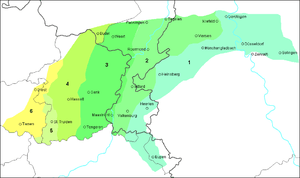Southeast Limburgish dialect
| Southern Meuse-Rhenish | |
|---|---|
| Native to | Netherlands, Belgium and Germany |
| Region | Limburg, North Rhine-Westphalia, Province of Liege |
Native speakers | 1.6 million (date missing) |
|
Indo-European
| |
| Language codes | |
| ISO 639-3 | – |
| Glottolog | None |
Southeast Limburgish (Dutch: Zuidoost-Limburgs, Ripuarian: Süüdoß-Limburjesch), also referred to as Southern Meuse-Rhenish, is a subdivision of what recently has been named Meuse-Rhenish. Both terms denote a rather compact grouping of Low Franconian varieties, spoken in the Limburg and Lower Rhineland regions, near the common Dutch/Flemish (Belgium) and Dutch/German borders. These dialectal varieties differ notably from Dutch and Flemish at the one side, and no less from German at the other. In the Netherlands and Belgium this group is often included in the generic term Limburgish. Limburgish was recently recognised as a regional language (streektaal) in the Netherlands and as such it receives moderate protection under chapter 2 of the European Charter for Regional or Minority Languages. The linguistic border of the Limburgish varieties to the South is the Benrath line, to the North it is the Uerdingen line. This means Southeast Limburgish is different in nature from the other Limburgish varieties.
Subdialects of Limburgish

6 & 5 West & East Geteland 4 West 3 Central 2 East 1 East Limburgish-Ripuarian
A lot of subgroupings can be made here.
- East Geteland, West Geteland and Bilzerland are transitional subdialects between Limburgish and South Brabantian. At least the majority of these are non-tonal. East Geteland (or Truierland) is spoken around St Truiden in Belgium. West Geteland is spoken up to the Uerdingen Line, which reaches the Dutch-Walloon language border at Bierbeek in Belgium. Other minor varieties include Bilzerland spoken around Genk in Belgium and Tongerland spoken around Tongeren in Belgium.
- West Limburgish is the variety of Limburgish spoken around Hasselt, and most other parts of Limburg in Belgium. In Germany West Limburgish is a concept including areas in Dutch Limburg and part of Dutch Brabant. The border between West Limburgish and East Limburgish starts near the area between the villages of 's-Gravenvoeren and Sint-Martens-Voeren in the Belgian municipality of Voeren.
- Central Limburgish is a variety of Limburgish around Maastricht and Heerlen in the Netherlands and Genk in Belgium. Central Limburgish is a concept used in Germany, which includes the area around Maastricht and stretches further North. In Germany there is also a concept of a variety of Limburgish around Genk, and another of Limburgish between Genk and Hasselt.
- East Limburgish as a concept is also used in Germany, which includes an area from Belgian Voeren South of Maastricht in the Netherlands, to an area in Germany including Dülken and central Krefeld.
- East Limburgish-Ripuarian transitional zone is a concept used in Germany to describe the linguistic area in Belgium around Eupen, including Welkenraedt, Lontzen and Moresnet, in the Netherlands between Ubach and Brunssum and a large area in Germany including Mönchengladbach. The southeasternmost variety is referred to as Southeast Limburgish (see below) and the northeasternmost variety is referred to as Low Bergish.
Southeast Limburgish around Aachen
| This article is a part of a series on |
| Dutch |
|---|
| Dutch Low Saxon dialects |
| West Low Franconian dialects |
| East Low Franconian dialects |
Southeast Limburgish is spoken around Kerkrade, Bocholtz and Vaals in the Netherlands, Aachen in Germany and Raeren and Eynatten in Belgium. In Germany it is sometimes considered as Ripuarian, not always as Limburgish. This explains why it is not distinctly marked on both maps (at right and below). These pictures, however, have to be fine-tuned for the transitional zone between Limburgish and Ripuarian. In Belgium, the southeastern boundary between Meuse-Rhenish (Du: Maas-Rijnlands, Fr: francique rhéno-mosan) and Ripuarian is formed by the so-called Low Dietsch (Limburgish: Platduutsj, Du: Platdiets, Fr: platdutch, francique carolingien) language area. According to a contemporary vision, all varieties in a wider half circle some 20 km around Aachen, including 2/3 of Dutch South Limburg and the Low Dietsch area between Voeren and Eupen in Belgium, can be taken as a group of its own, which recently has been named "Tri-state Limburgish" (Dutch: Drielandenlimburgs, German: Dreiländerplatt), referring to the place where the Netherlands, Belgium and Germany meet (Welschen 2005, Frins 2005, 2006). This variety still possesses interesting syntactic idiosyncrasies, probably dating from the period in which the old Duchy of Limburg existed.
Relation to Ripuarian
If only tonality is to be taken as to define this variety, both Southeast Limburgish and Ripuarian belong to a broader class of Meuse-Rhenish varieties in a wider sense. This tonal language group stretches rather deep into Germany, even across the Rhine up to Siegen. In Germany, it is consensus to class both varieties as belonging to High German varieties. But this is a little over-simplified. In order to include this variety properly a more encompassing concept is needed. The combination of Meuse-Rhenish and Ripuarian, including their overlapping transitional zones of Southeast Limburgish and Low Dietsch, will do.
Classification
- Indo-European
- Germanic
- West Germanic
- Low Franconian
- East Low Franconian (Limburgish)
- Southeast Limburgish
- East Low Franconian (Limburgish)
- Low Franconian
- West Germanic
- Germanic
See also
References
- Georg Cornelissen 2003: Kleine niederrheinische Sprachgeschichte (1300-1900) : eine regionale Sprachgeschichte für das deutsch-niederländische Grenzgebiet zwischen Arnheim und Krefeld [with an introduction in Dutch]. Geldern / Venray: Stichting Historie Peel-Maas-Niersgebied, ISBN 978-90-807292-2-3